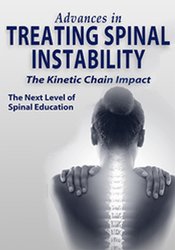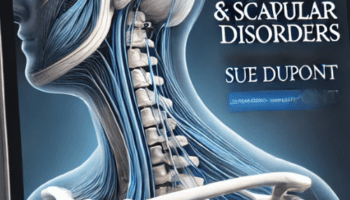Advances in Treating Spinal Instability -The Kinetic Chain Impact – Sue DuPont
Advances in Treating Spinal Instability -The Kinetic Chain Impact – Sue DuPont has the same quality as the author’s salapage.
Overview
Salepage check: Advances in Treating Spinal Instability -The Kinetic Chain Impact
Author: Sue DuPont
- Faculty:
- Sue DuPont
- Duration:
- 6 Hours 6 Minutes
- Format:
- Audio and Video
- Copyright:
- Mar 18, 2016
Description
The Next Level of Spinal Education
Nearly 80% of adults will experience Low Back Pain, (LBP) and seek care in outpatient clinics. Evidence has been inconclusive for the best treatment techniques – especially for spinal stabilization programs. However, new research from electromyography (EMG) studies has provided an improved understanding of how functional movement, muscle imbalances, and ineffective load transfer through the lumbo-pelvic-hip complex increase risk of injury along the entire lower kinetic chain.
Explore the role of movement and muscle imbalances on pain and dysfunction in the spine and lower extremities by using gait, posture, functional movement analysis, and simple clinical tests. Identify true lumbar instability, myofascial sling, and joint dysfunctions that may be contributing to your patient’s pain. Discover the latest clinical prediction rules for LBP to guide your treatment planning, and incorporate manual therapy, stabilization, and exercise into your treatment.
Take core, balance, and proprioceptive training to the next level with an interactive, hands-on lab — learn manual techniques to rebalance tissue dysfunctions and how to develop an effective corrective exercise program utilizing inexpensive equipment such as foam rollers. With a more focused approach you will get better outcomes in less time — and you and your patient will have fun in the process!
Handouts
| Manual – Advances in Treating Spinal Instability (18.75 MB) | 102 Pages | Available after Purchase | |
| Handout – Advances in Treating Spinal Instability (0.22 MB) | Available after Purchase |
Outline
INTRODUCTION
BACK PAIN: WHY IT’S A PROBLEM
- Biotensegrity: The Anti-Gravity Model
- Role of the “Core” stiffness or movement?
- Myofascial connections and their role in stabilization and function
LAB #1 — MYOFASCIAL MOBILIZATIONS
BACK PAIN: ARE WE CHASING THE PAIN?
- Structural vs. functional pathology
- Effects of sustained postures and forces
- Effects of chronic pain and dysfunction on movement
WHAT IS SPINAL INSTABILITY?
- Ambiguity of term spinal instability
- Disconnect between medical diagnosis and clinical signs and symptoms
- Historical perspective of spinal instability
- Muscle dysfunction and lumbar spinal instability
- Functional vs. pathological muscle imbalances
- Rehab goal for muscle imbalances
KINETIC CHAIN REHAB FOR FUNCTIONAL MOVEMENT
- Kinetic chain rehab principles
- Functional coupling between muscles and fascia
- Components for optimal functional movement
- Myofascial slings and common dysfunctions
- Biomechanical link between lower kinetic chain and spinal instability
IS SPINAL INSTABILITY JUST ABOUT STIFFNESS?
- Static vs. dynamic spinal instability
- Synergist, agonist, and antagonist effects of muscles and force vectors
WHERE ARE WE NOW?
- Motor control vs. general exercise
- Clinical prediction rules for back pain
- Influence of posture and body type
- Muscle sling dysfunctions – “Gluteal Amnesia,” Quadratus Lumborum Syndrome, etc.
- Importance of dynamic functional movement analysis
LAB #2 – POSTURE, ROM, & MUSCLE LENGTH
SPINAL INSTABILITY: CLINICAL PRESENTATION & OBSERVATIONS
- Patient case studies
- Finding myofascial imbalances and compensatory patterns
- Best clinical tests for spinal instability
- Clinical “pearls” for determining weak quadrant
LAB #3 — DYNAMIC FUNCTIONAL MOVEMENT OBSERVATIONS & CLINICAL ANALYSIS
CORRECTIVE EXERCISE PROGRESSIONS FOR SPINAL INSTABILITY
- Motor control of local stabilizers
- Adding tri-planar stabilization
- Turning on the gluteal muscles
- Progression of Spinal Stabilization Exercises
- EMG evidence-guided progressions
- Adding equipment and unlevel surfaces
- 5 functional tasks to ALWAYS include
LAB #4 — PRACTICE CORRECTIVE EXERCISE PROGRESSIONS LIVE CASE STUDY
- Identify and develop a treatment plan
- Myofascial sling dysfunction and spinal instability
RESOLUTION
Faculty

Sue DuPont, MS, MBA, PT, ATC Related seminars and products: 6
Sue DuPont, MS, MBA, PT, ATC, is an expert in the field of orthopedics and sports medicine, with over 30 years of experience treating patients and athletes of all ages and activity levels. She holds multiple degrees including a B.S. in Exercise Science/Athletic Training, an M.S. in Biology specializing in Biomechanics, a post-baccalaureate degree in Physical Therapy, and an MBA in Healthcare Management. Ms. DuPont was on the Medical Staff at the 1996 Summer Olympic Games and awarded a 1-year fellowship at the U.S. Olympic Training Center. She has worked with various professional and elite athletes, from WTA pro tennis to World Cup Figure Skating. While working with the U.S.O.C. Biomechanics Division, Ms. DuPont researched and developed a Clinical Plyometrics protocol and presented the findings at the APTA National Conference.
Ms. DuPont has taught courses specifically for seniors on healthy aging and wellness. She is a veteran ACE Certified Fitness Instructor, teaching Pilates, kickboxing, and many other fitness courses for over 20 years. Ms. DuPont has performed extensive research on the spine, aging, balance, and fitness. In her clinical practice, she utilizes advanced clinical techniques in manual therapy, taping/strapping, active stabilization, and soft tissue release to improve functional movement patterns. Currently, Ms. DuPont teaches continuing education courses nationwide. When home in Florida, she treats patients/clients for physical therapy and wellness and sits on the Advisory Board for Southwest Florida University’s PTA program.
Speaker Disclosures:
Financial: Sue DuPont has an employment relationship with Joint Implant Surgeons of Florida. She receives a speaking honorarium from PESI, Inc.
Non-financial: Sue DuPont has no relevant non-financial relationship to disclose.
Curriculum
FAQs
Requirements
- A basic understanding of spinal anatomy and the kinetic chain.
- Access to a digital device with an internet connection to stream the course materials.
- Recommended: Prior experience in physical therapy, chiropractic care, or sports rehabilitation.
Features
- Comprehensive Modules: Dive deep into the latest techniques for managing spinal instability and their effects on the kinetic chain.
- Case Studies: Analyze real-world scenarios to apply the techniques effectively.
- Expert Guidance: Learn directly from Sue DuPont, a renowned expert in spinal health.
- Interactive Exercises: Practical insights into rehabilitation exercises.
- Evidence-Based Approach: Grounded in the latest research and clinical practices.
Target audiences
- Physical therapists seeking advanced knowledge in spinal instability treatment.
- Chiropractors specializing in kinetic chain corrections.
- Sports medicine practitioners aiming to enhance their skill set.
- Students and educators in rehabilitation sciences.



